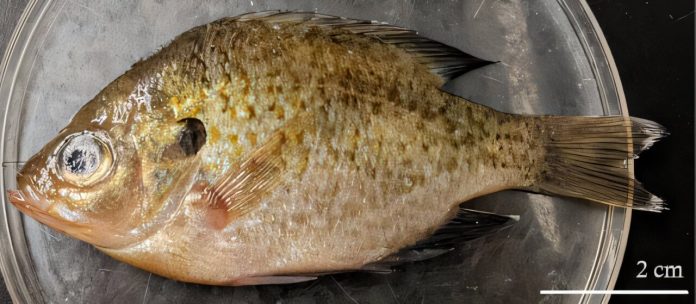
A new study has found that more than 90% of freshwater game fish in Southern California are carrying parasites that can infect humans.
These parasites, which were introduced to the U.S. in recent decades, are not native to the region and are now found in popular fishing spots.
The study was conducted by scientists at UC San Diego’s Scripps Institution of Oceanography and published in the Journal of Infectious Diseases.
The parasites are flatworms known as trematodes, and two species—Haplorchis pumilio and Centrocestus formosanus—were identified in the study.
These parasites have long been known to infect humans in parts of Southeast Asia, where they can cause stomach issues, fatigue, and weight loss. In rare cases, repeated or severe infections have even led to heart attacks or strokes.
Although no cases of these parasites infecting Americans have been reported yet, researchers believe that’s likely because doctors in the U.S. don’t know to look for them, and there’s no requirement to report such infections. That could soon change if awareness grows.
The parasites first arrived in the United States through an invasive aquatic snail, commonly known as the Malaysian trumpet snail (Melanoides tuberculata).
This snail is now found in at least 17 states and Puerto Rico. The trematodes begin their life cycle in these snails, move into fish, and finally infect birds or mammals—like humans—when they eat raw or undercooked fish.
In this study, researchers collected 84 fish from five popular fishing spots in San Diego County.
These fish, including largemouth bass and bluegill, are commonly caught and eaten by people in the region. The results were surprising: 93% of the fish carried Haplorchis pumilio, and some had thousands of these parasites inside them.
The second species, Centrocestus formosanus, was found in two of the five fishing spots and infected 91% of fish sampled there.
Lead researcher Ryan Hechinger, an ecologist and parasitologist at Scripps, says people in the U.S. usually don’t think of parasites when eating freshwater fish. But with these invasive trematodes now widespread, he believes both the public and healthcare providers need to be better informed.
The good news is that avoiding infection is simple. Cooking fish thoroughly or freezing it for at least one week before eating it raw will kill the parasites, according to FDA guidelines. However, a social media analysis conducted by the researchers found that many people are likely eating raw freshwater fish without taking these precautions.
The team reviewed 125 YouTube videos, totaling nearly 5 million views, where people prepared and ate freshwater fish. Alarmingly, 65% of the videos didn’t mention freezing or cooking the fish properly, potentially encouraging risky behavior.
Co-author Emma Palmer, who conducted the research during her graduate studies, emphasized that the widespread interest in catching and eating freshwater fish needs to be matched by greater awareness of food safety.
The researchers plan to share their findings with public health officials across Southern California and hope doctors will consider fish-borne parasites when diagnosing unexplained stomach or fatigue issues. They also suggest making infections from these parasites reportable diseases, which would help track the problem and protect public health more effectively.



